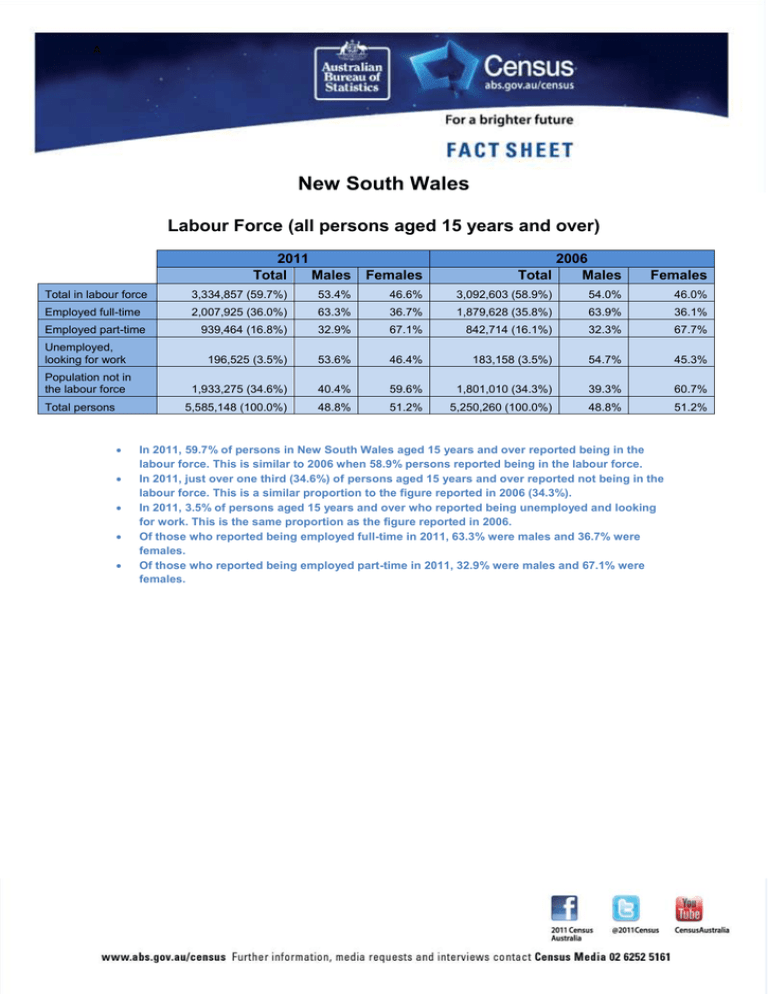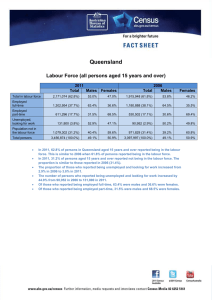New South Wales A
advertisement

A New South Wales Labour Force (all persons aged 15 years and over) 2011 Total Males Females 2006 Total Males Females Total in labour force 3,334,857 (59.7%) 53.4% 46.6% 3,092,603 (58.9%) 54.0% 46.0% Employed full-time 2,007,925 (36.0%) 63.3% 36.7% 1,879,628 (35.8%) 63.9% 36.1% 939,464 (16.8%) 32.9% 67.1% 842,714 (16.1%) 32.3% 67.7% 196,525 (3.5%) 53.6% 46.4% 183,158 (3.5%) 54.7% 45.3% 1,933,275 (34.6%) 40.4% 59.6% 1,801,010 (34.3%) 39.3% 60.7% 5,585,148 (100.0%) 48.8% 51.2% 5,250,260 (100.0%) 48.8% 51.2% Employed part-time Unemployed, looking for work Population not in the labour force Total persons In 2011, 59.7% of persons in New South Wales aged 15 years and over reported being in the labour force. This is similar to 2006 when 58.9% persons reported being in the labour force. In 2011, just over one third (34.6%) of persons aged 15 years and over reported not being in the labour force. This is a similar proportion to the figure reported in 2006 (34.3%). In 2011, 3.5% of persons aged 15 years and over who reported being unemployed and looking for work. This is the same proportion as the figure reported in 2006. Of those who reported being employed full-time in 2011, 63.3% were males and 36.7% were females. Of those who reported being employed part-time in 2011, 32.9% were males and 67.1% were females. A New South Wales Weekly Hours Worked (employed persons aged 15 years and over) 2011 Total Males 40 hours and above Females 2006 Total Males Females 1,438,260 (45.8%) 67.6% 32.4% 1,381,400 (47.5%) 67.9% 32.1% 35-39 hours 569,664 (18.2%) 52.4% 47.6% 498,228 (17.1%) 52.8% 47.2% 25-34 hours 308,121 (9.8%) 33.6% 66.4% 272,330 (9.4%) 34.1% 65.9% 16-24 hours 304,829 (9.7%) 31.2% 68.8% 267,056 (9.2%) 30.0% 70.0% 0-15 hours 446,637 (14.2%) 36.2% 63.8% 406,853 (14.0%) 36.1% 63.9% 3,138,332 (100.0%) 53.4% 46.6% 2,909,444 (100.0%) 54.0% 46.0% Total persons Of all employed persons aged 15 years and over 45.8% reported working 40 hours or more in the week prior to the 2011 Census. A higher proportion of these were males (67.6%). Between the 2006 and 2011 Census there was a 1.7 percentage point decline in the proportion of persons who reported working 40 hours or more (47.5% in 2006 compared to 45.8% in 2011). Of all employed persons aged 15 years and over 14.2% reported working 0 to 15 hours in the week prior to the 2011 Census. A higher proportion of these were females (63.8%). A New South Wales Top five Industries in 2011 (employed persons aged 15 years and over) 2011 Total Males Health Care and Social Assistance Retail Trade Manufacturing Education and Training Professional, Scientific and Technical Services Total persons Females 2006 Total Males Females 364,321 (11.6%) 324,726 (10.3%) 264,866 (8.4%) 248,951 (7.9%) 21.7% 43.0% 72.6% 30.5% 78.3% 57.0% 27.4% 69.5% 304,341 (10.5%) 323,929 (11.1%) 277,985 (9.6%) 219,677 (7.6%) 22.3% 43.2% 72.8% 30.6% 77.7% 56.8% 27.2% 69.4% 247,294 (7.9%) 3,138,332 (100.0%) 54.9% 53.4% 45.1% 46.6% 213,254 (7.3%) 2,909,444 (100.0%) 54.2% 54.0% 45.8% 46.0% In 2011, of all employed persons aged 15 years and over the largest proportion reported working in the Health Care and Social Assistance industry (11.6%). In 2006, the Retail Trade industry was the most reported response for employed persons aged 15 years and over (11.1%). The proportion of those who reported being employed in this industry declined to 10.3% in 2011, however there has been a minor increase in the number of persons employed in this industry (797 persons). The proportion of person employed persons aged 15 years and over who reported Manufacturing as their industry of employment has declined to 8.4% in 2011 compared to 9.6% in 2006, and there has been a decrease in the number of persons who reported being employed in this industry (13,119 persons). In 2011, of persons who reported working in the Manufacturing industry, 72.6% were males. In 2011, of persons employed in the industries of Health Care and Social Assistance, Education and Training and Retail Trade, a higher proportion were females (78.3%, 69.5% and 57.0% respectively). A New South Wales Top five Occupations in 2011 (employed persons aged 15 years and over) 2011 Total Males Professionals Clerical and Administrative Workers Managers Technicians and Trades Workers Community and Personal Service Workers Total persons Females Total 2006 Males Females 713,548 (22.7%) 46.8% 53.2% 616,282 (21.2%) 47.5% 52.5% 473,141 (15.1%) 418,333 (13.3%) 24.1% 64.3% 75.9% 35.7% 447,952 (15.4%) 396,461 (13.6%) 23.6% 65.4% 76.4% 34.6% 414,669 (13.2%) 84.9% 15.1% 396,723 (13.6%) 85.3% 14.7% 297,669 (9.5%) 3,138,332 (100.0%) 32.6% 53.4% 67.4% 46.6% 249,579 (8.6%) 2,909,444 (100.0%) 33.1% 54.0% 66.9% 46.0% In 2011, 22.7% of all employed persons aged 15 years and over reported working as Professionals. Of those, 53.2% were females. The proportion of persons who reported working as Professionals has increased by 1.5 percentage points from 21.2% in 2006 to 22.7% in 2011. In 2011, of those who reported working as Technicians and Trades Workers (13.2%), a higher proportion were males (84.9%). In 2011, of all persons who reported working as Clerical and Administrative Workers (15.1%), a higher proportion were females (75.9%). A New South Wales Highest Level of Education (all persons aged 15 years and over) 2011 Total Males Postgraduate Degree Graduate Diploma & Certificate Females Total 2006 Males Females 162,916 (3.1%) 56.6% 43.4% 238,853 (4.3%) 53.5% 46.5% 82,616 (1.5%) 37.7% 62.3% 65,829 (1.3%) 37.2% 62.8% 787,335 (14.1%) 44.9% 55.1% 635,027 (12.1%) 46.0% 54.0% 462,060 (8.3%) 42.1% 57.9% 387,653 (7.4%) 41.2% 58.8% Certificate III/IV 819,782 (14.7%) 70.3% 29.7% 718,478 (13.7%) 74.4% 25.6% Year 12 883,963 (15.8%) 47.7% 52.3% 804,097 (15.3%) 47.5% 52.5% 1,577,920 (28.3%) 43.0% 57.0% 1,649,800 (31.4%) 42.1% 57.9% 5,585,148 (100.0%) 48.8% 51.2% 5,250,260 (100.0%) 48.8% 51.2% Bachelor Degree Advanced Diploma and Diploma Year 11 or below (includes Certificate I/II/nfd) Total persons nfd: Not further defined In 2011, there was a significant increase in number of persons who reported completing a Postgraduate Degree, from 162,916 in 2006 to 238,853 in 2011 (an increase of 46.6%). There has been significant increase in numbers of those who reported completing a Graduate Diploma or Graduate Certificate as their highest level of education. This increased from 65,829 in 2006 to 82,616 in 2011 (an increase of 25.5%). There was significant increase in the number of persons who reported completing a Bachelor Degree as their highest level of education, from 635,027 in 2006 to 787,335 in 2011 (an increase of 24.0%). There has been a decline in number of those who reported Year 11 and below, including Certificate level I/II), as their highest level of education, from 1,649,800 in 2006 to 1,577,920 in 2011. A higher proportion of females than males reported their highest level of education as Graduate Diploma or Graduate Certificate, Bachelor Degree, and Advance Diploma or Diploma (62.3%, 55.1% and 57.9% respectively). Of all persons who reported completing Certificate III/IV as their highest level of education a higher proportion were males (70.3%). A New South Wales Top five Fields of Study in 2011 (all persons aged 15 years and over who stated a completed qualification) Management and Commerce Engineering and Related Technologies Society and Culture Health Education Total persons Total 2011 Males Females Total 2006 Males Females 647,875 (20.3%) 39.7% 60.3% 525,056 (18.4%) 38.8% 61.2% 471,736 (14.8%) 325,402 (10.2%) 271,405 (8.5%) 228,393 (7.1%) 3,196,923 (100.0%) 92.6% 35.1% 23.2% 24.9% 51.3% 7.4% 64.9% 76.8% 75.1% 48.7% 442,431 (15.5%) 249,003 (8.7%) 227,949 (8.0%) 200,582 (7.0%) 2,860,459 (100.0%) 92.8% 37.7% 22.7% 25.7% 52.3% 7.2% 62.3% 77.3% 74.3% 47.7% In 2011, Management and Commerce (20.3%) and Engineering and Related Technologies (14.8%) were the two most common fields of study that were reported by all persons aged 15 years and over who stated a completed qualification. These fields were also reported as the most common fields of study in the 2006 Census. Between the 2006 Census and 2011 Census, there has been a decline in the proportion of those who reported Engineering and Related Technologies (0.7 percentage points). In addition there has been a proportionate increase in those who reported Management and Commerce (1.9 percentage points). Of all persons who reported Management and Commerce as their field of study a higher proportion were females (60.3%). Of all persons who reported Engineering and Related Technologies as their field of study, the proportion of males was significantly higher (92.6%). Three quarters of those who reported Health and Education as fields of study were females (76.8% and 75.1% respectively). A New South Wales Top five Methods of Travel to Work in 2011 (employed persons aged 15 years and over) Car, as driver Train Car, as passenger Walked only Bus Total persons 2011 Total Persons 2006 Total Persons 1,807,358 (57.6%) 193,098 (6.2%) 157,358 (5.0%) 128,342 (4.1%) 116,658 (3.7%) 3,138,332 (100.0%) 1,639,530 (56.4%) 158,002 (5.4%) 166,870 (5.7%) 127,442 (4.4%) 100,058 (3.4%) 2,909,444 (100.0%) Transport by car continues to be the most commonly reported method of travel to work. Almost two thirds (62.6%) of employed persons reported that they travelled to work by car (either as driver or a passenger) on 9 August 2011. The number of those who travelled to work by train has increased from 158,002 (5.4%) in 2006 to 193,098 (6.2%) in 2011. The number of those who walked to work has increased slightly from 127,442 in 2006 to 128,342 in 2011, however the proportion of persons who walked to work has declined from 4.4% in 2006 to 4.1% in 2011 (reflecting a slower rate of growth compared to other forms of travel). A New South Wales Place of Usual Residence one year ago (all persons who moved, excluding persons aged under one year) 2011 2006 771,843 (81.6%) 765,776 (82.6%) Interstate 70,238 (7.4%) 63,514 (6.9%) Overseas 92,848 (9.8%) 88,556 (9.6%) 946,006 (100.0%) 927,017 (100.0%) Within State Total persons Of the New South Wales residents who moved in the year prior to the 2011 Census, most moved within the State (81.6%). There were 92,848 (9.8%) of persons who had moved to New South Wales from overseas in the year prior to 2011. Place of Usual Residence five years ago (all persons who moved, excluding persons aged under five years) 2011 2006 1,832,678 (77.0%) 1,855,650 (80.0%) Interstate 171,143 (7.2%) 162,535 (7.0%) Overseas 349,110 (14.7%) 277,958 (12.0%) 2,380,678 (100.0%) 2,321,298 (100.0%) Within State Total persons More than three quarters (77.0%) of the New South Wales residents who moved five years prior to the 2011 Census moved within the State. There were 349,110 (14.7%) of persons who had moved to New South Wales from overseas five years prior to the 2011 Census.






